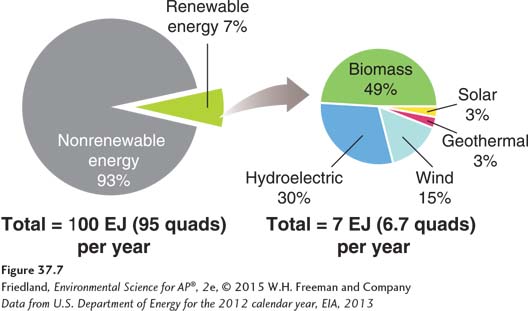module 37 Conservation, Efficiency, and Renewable Energy
In any discussion of energy use—
Learning Objectives
After reading this module you should be able to
describe strategies to conserve energy and increase energy efficiency.
explain differences among the various renewable energy resources.
We can use less energy through conservation and increased efficiency
A truly sustainable approach to energy use must incorporate both energy conservation and energy efficiency. Conservation and efficiency efforts save energy that can then be used later, just as you might save money in a bank account to use later when the need arises. In this sense, conservation and efficiency are sustainable energy “sources.”
Energy conservation and energy efficiency are the least expensive and most environmentally sound options for maximizing our energy resources. In many cases, they are also the easiest approaches to implement because they require fairly simple changes to existing systems rather than a switch to a completely new technology. In this section we will examine ways to achieve both objectives.
Energy Conservation and Efficiency
Energy conservation Finding and implementing ways to use less energy.
Energy conservation means finding and implementing ways to use less energy. As we saw in Chapters 2 and 12, increasing energy efficiency means obtaining the same work from a smaller amount of energy. Energy conservation and energy efficiency are closely linked. One can conserve energy by not using an electrical appliance; doing so results in less energy consumption. But one can also conserve energy by using a more efficient appliance—
Conservation
Tiered rate system A billing system used by some electric companies in which customers pay higher rates as their use goes up.
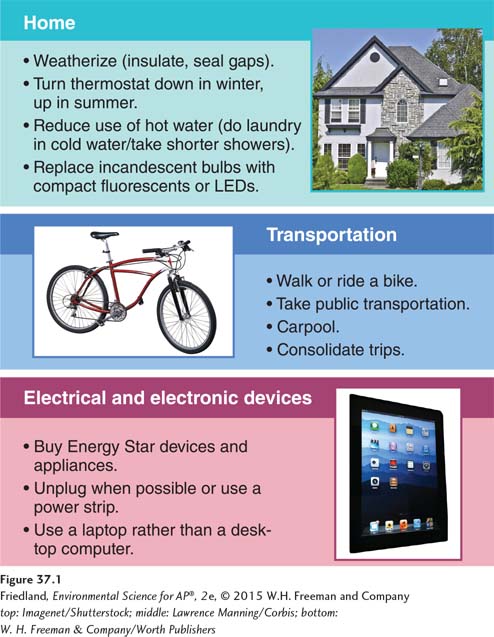
FIGURE 37.1 lists some of the ways that an individual might conserve energy, including lowering the household thermostat during cold months, consolidating errands in order to drive fewer miles, or turning off a computer when it is not being used. On a larger scale, a government might implement energy conservation measures that encourage or even require individuals to adopt strategies or habits that use less energy. One such top-
Peak demand The greatest quantity of energy used at any one time.
As we saw in Chapter 12, the demand for energy varies with time of day, season, and weather. When electricity-
Therefore, an important aspect of energy conservation is the reduction of peak demand, which would make it less likely that electric companies will have to build excess generating capacity that is used only sporadically. One way of reducing peak demand is to set up a variable price structure under which customers pay less to use electricity when demand is lowest (typically in the middle of the night and on weekends) and more when demand is highest. This approach helps even out the use of electricity, which both reduces the burden on the generating capacity of the utility and rewards the electric consumer at the same time.
The second law of thermodynamics tells us that whenever energy is converted from one form into another, some energy is lost as unusable heat. In a typical thermal fossil fuel or nuclear power plant, only about one-
Efficiency
Modern changes in electric lighting are a good example of how steadily increasing energy efficiency results in overall energy conservation. Compact fluorescent light bulbs use one-
Another way in which consumers can increase energy efficiency is by switching to products that meet the efficiency standards of the Energy Star program set by the U.S. Environmental Protection Agency. For example, an Energy Star air conditioner may use 0.2 kilowatt-
Sustainable Design
Sustainable design can improve the efficiency of the buildings and communities in which we live and work. FIGURE 37.2 shows some key features of sustainable design applied to a single-
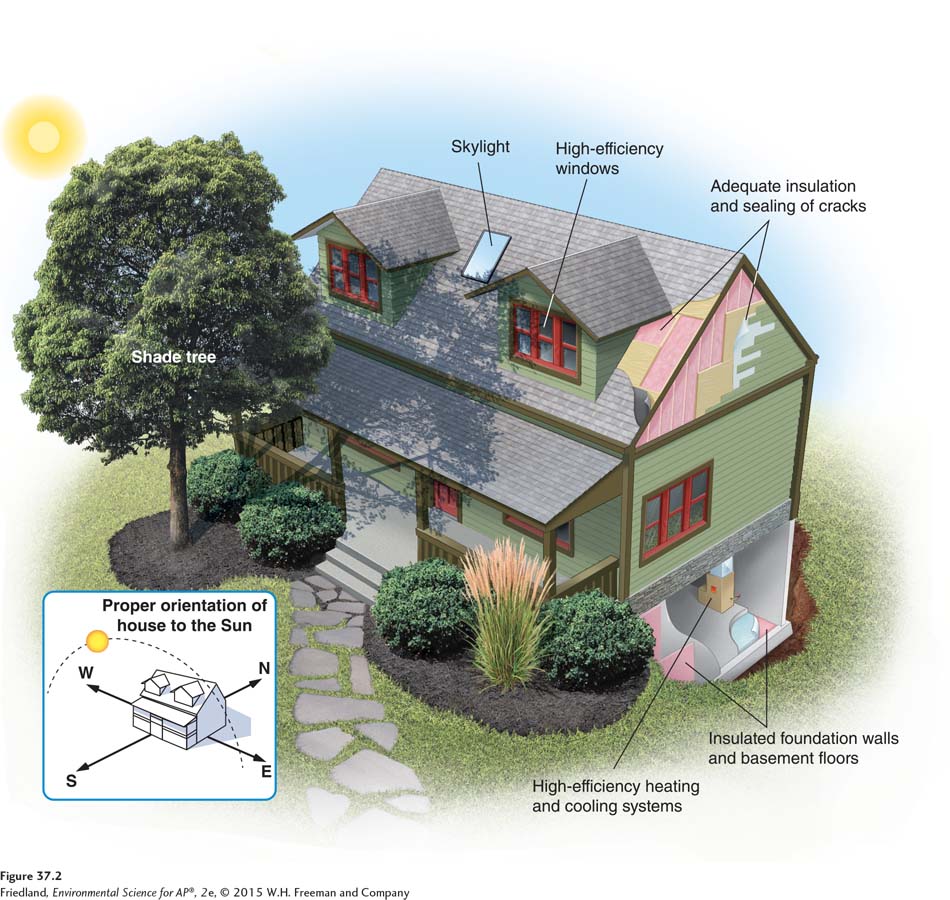
Passive solar design Construction designed to take advantage of solar radiation without active technology.
Buildings consume a great deal of energy for cooling, heating, and lighting. Many sustainable building strategies rely on passive solar design, a construction technique designed to take advantage of solar radiation without the use of active technology. FIGURE 37.3 illustrates key features of passive solar design. Passive solar design stabilizes indoor temperatures without the need for pumps or other mechanical devices. For example, in the Northern Hemisphere, constructing a house with windows along a south-
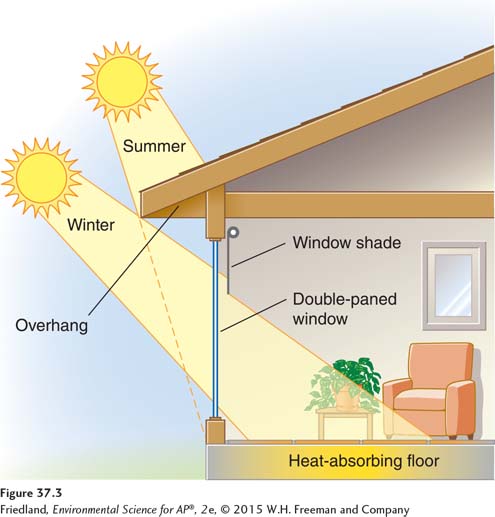
Thermal mass A property of a building material that allows it to maintain heat or cold.
To reduce demand for heating at night and for cooling during the day, builders can use construction materials that have high thermal mass. Thermal mass is a property of a building material that allows it to retain heat or cold. Materials with high thermal mass stay hot once they have been heated and cool once they have been cooled. Stone and concrete have high thermal mass, whereas wood and glass do not; think of how a cement sidewalk stays warm longer than a wooden boardwalk after a hot day. A south-
Although building a house into the side of a hill or roofing a building with soil and plants are less-
The use of recycled building materials is another method of energy conservation. Recycling reduces the need for new construction materials, which reduces the amount of energy required to produce the components of the building. For example, many buildings now use recycled denim insulation in the walls and ceilings, and fly ash (a byproduct recovered from coal-
Many homes constructed today incorporate some or all of these sustainable design strategies, but it is possible to achieve energy efficiency even in very large buildings. The building that houses the California Academy of Sciences in Golden Gate Park in San Francisco is a showcase for several of these sustainable design techniques (FIGURE 37.4). This structure, which incorporates a combination of passive solar design, radiant heating, solar panels, and skylights, actually uses 30 percent less energy than the amount permitted under national building energy requirements. Natural light fills 90 percent of the office space and many of the public areas. Windows, blinds, and skylights open as needed to allow air to circulate, capturing the ocean breezes and ventilating the building. Recycled denim insulation in the walls and a soil-
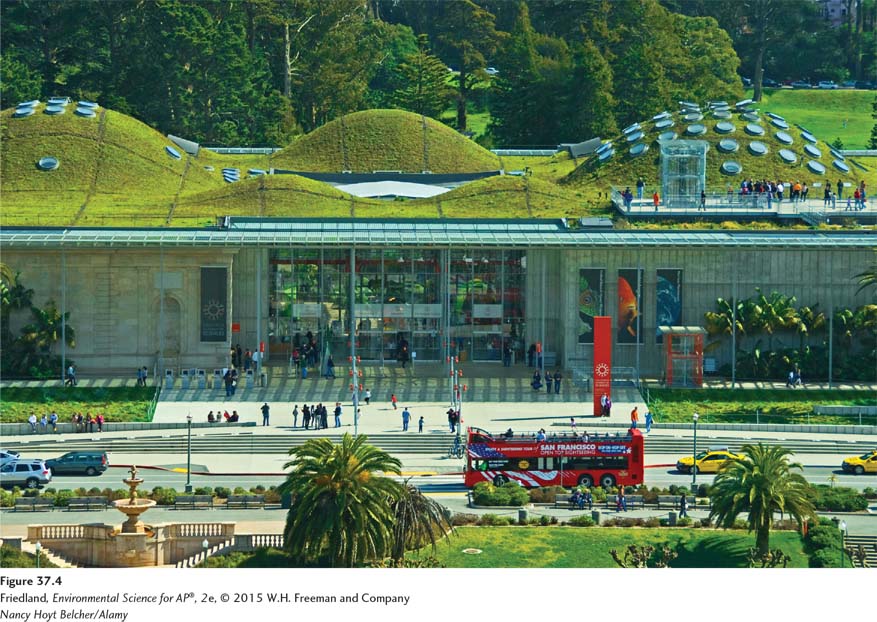
In addition to these passive techniques, the designers of this building incorporated active technologies that further reduce its use of energy. An efficient radiant heating system carries warm water through tubes embedded in the concrete floor, using a fraction of the energy required by a standard forced-
The California Academy of Sciences took an innovative approach to meeting its energy needs through a combination of energy efficiency and use of renewable energy resources. However, many, if not all, of these approaches will have to become commonplace if we are going to use energy in a sustainable way.
Renewable energy is either potentially renewable or nondepletable
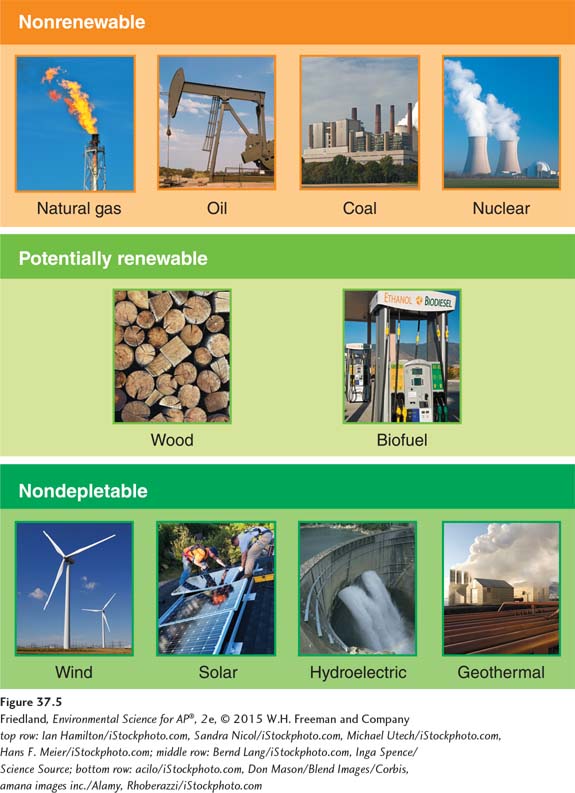
As fossil fuels become less available and more expensive, what will take their place? Probably it will be a mix of energy efficiency strategies, energy conservation, and new energy sources. In the rest of this chapter we will explore our renewable energy options.
In Chapter 12 we learned that conventional energy resources, such as petroleum, natural gas, coal, and uranium ore, are nonrenewable. From a systems analysis perspective, fossil fuels constitute an energy reservoir we are depleting much faster than it can ever be replenished. Similarly, we have a finite amount of uranium ore available to use as fuel in nuclear reactors.
Potentially renewable An energy source that can be regenerated indefinitely as long as it is not overharvested.
Nondepletable An energy source that cannot be used up.
Renewable In energy management, an energy source that is either potentially renewable or nondepletable.
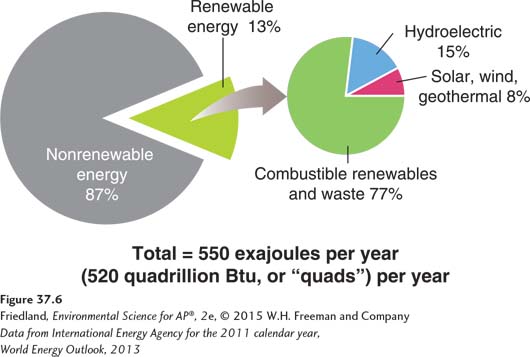
In contrast, some other sources of energy can be regenerated rapidly. Biomass energy resources are potentially renewable because those resources can be regenerated indefinitely as long as we do not consume them more quickly than they can be replenished. There are still other energy resources that cannot be depleted no matter how much we use them. Solar, wind, geothermal, hydroelectric, and tidal energy are essentially nondepletable in the span of human time; no matter how much we use there will always be more. The amount of a nondepletable resource available tomorrow does not depend on how much we use today. In this book we refer to potentially renewable and nondepletable energy resources together as renewable energy resources. FIGURE 37.5 illustrates the categories of energy resources.
Many renewable energy resources have been used by humans for thousands of years. In fact, before humans began using fossil fuels, the only available energy sources were wood and plants, animal manure, and fish or animal oils. Today, in parts of the developing world where there is little access to fossil fuels, people still rely on local biomass energy sources such as manure and wood for cooking and heating—
As FIGURE 37.6 shows, renewable energy resources account for approximately 13 percent of the energy used worldwide, most of which is in the form of biomass. In the United States, which depends heavily on fossil fuels, renewable energy resources provide only about 7 percent of the energy used. That 7 percent, shown in detail in FIGURE 37.7, comes primarily from biomass and hydroelectricity.
